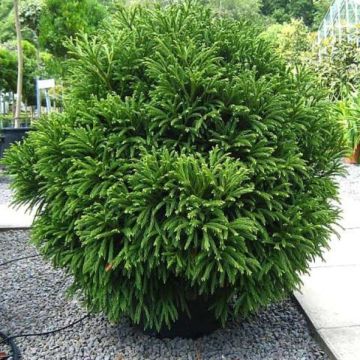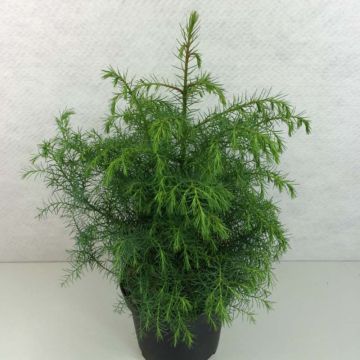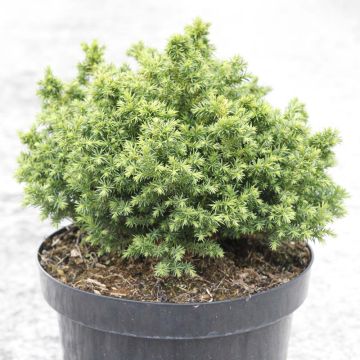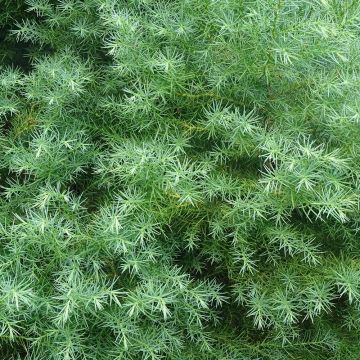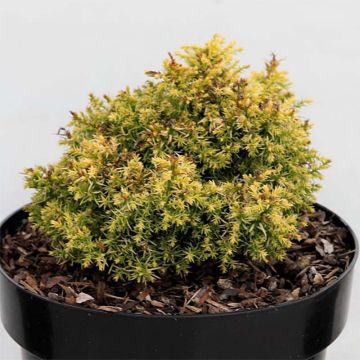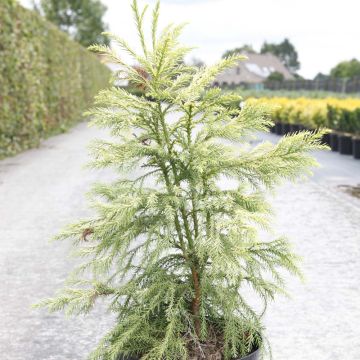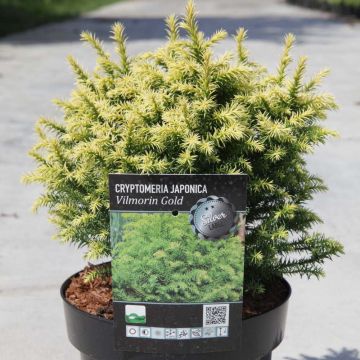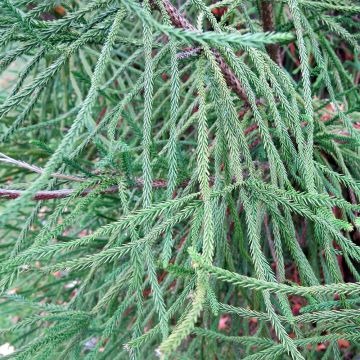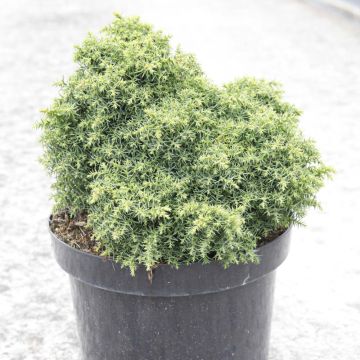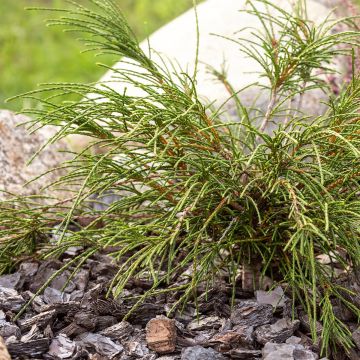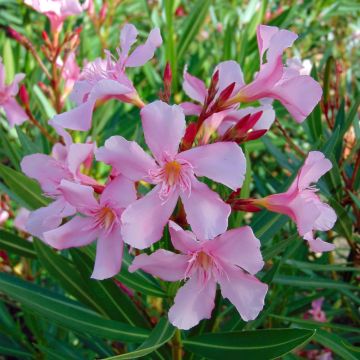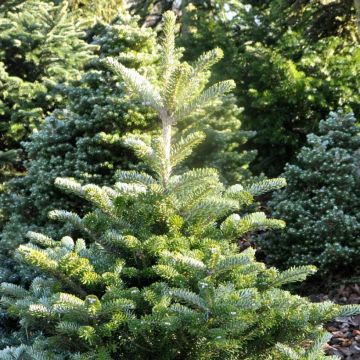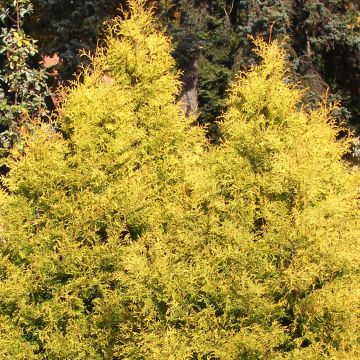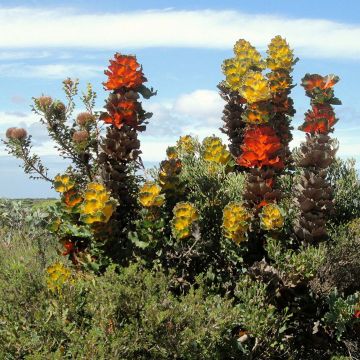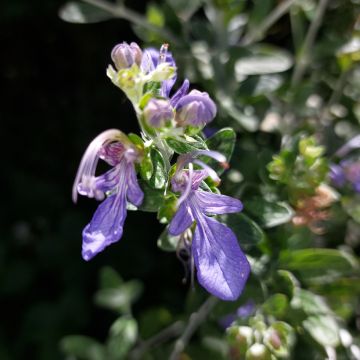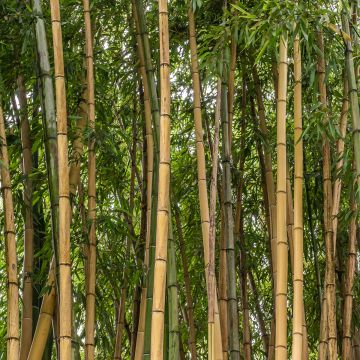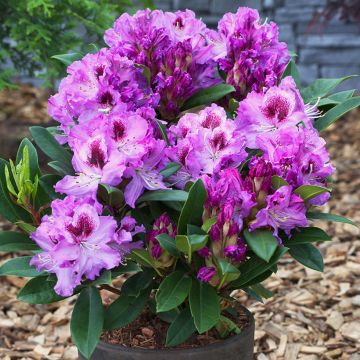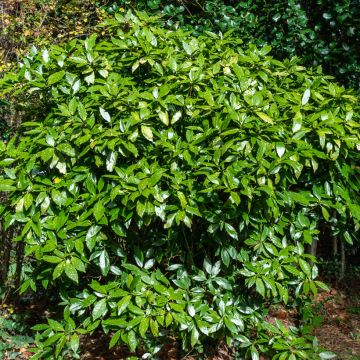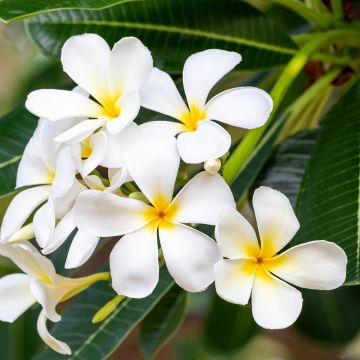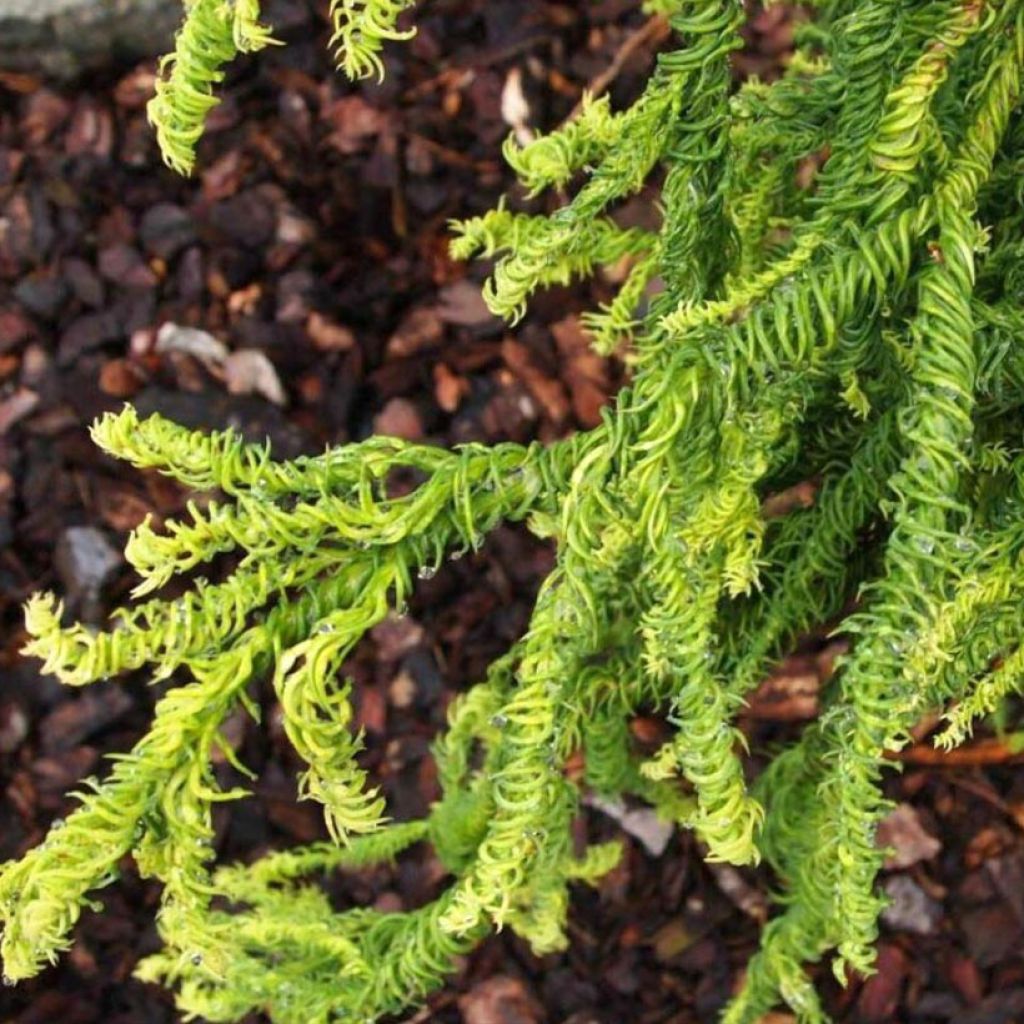

Cryptomeria japonica Kyara Gold - Japanese cedar
Cryptomeria japonica Kyara Gold - Japanese cedar
Cryptomeria japonica Kyara Gold®
Japanese cedar, Japanese redwood
This item cannot be shipped to the selected country
Delivery charge from €5.90
More information
Schedule delivery date,
and select date in basket
This plant carries a 24 months recovery warranty
More information
We guarantee the quality of our plants for a full growing cycle, and will replace at our expense any plant that fails to recover under normal climatic and planting conditions.
From €5.90 for pickup delivery and €6.90 for home delivery
Express home delivery from €8.90.
Does this plant fit my garden?
Set up your Plantfit profile →
Description
Cryptomeria japonica 'Kyara Gold' is an atypical form of Japanese cedar, with slightly variegated foliage, whose entire branches are arranged in a spiral, from the branches to the needles. This relatively small conifer has an irregular and charming habit, covered with bright foliage. It can be showcased in the middle of a large flowerbed or as a solitary specimen. The Japanese cedar adapts to any well-drained soil, not too dry, and without excessive limestone.
Cryptomeria japonica 'Kyara Gold' was obtained by mutating a branch of a 'Rasen' Cryptomeria that had cream-yellow variegation on its young shoots. The species, Cryptomeria japonica, is a very tall conifer from the taxodiaceae family native to Japan. In its country of origin, this tree is commonly planted around religious temples. It is a light and mild oceanic climate species, both humid all year round and mild in winter. In Asia, this forest tree resembling a sequoia can reach heights of up to 60m, standing on a trunk with a diameter of 4m covered with reddish-brown bark that peels off in vertical flakes. The foliage is evergreen in winter. It consists of curved needles spirally arranged around the branchlets. The Japanese cedar has given rise to numerous cultivars selected for their small size, foliage appearance, original habit, cold resistance, and better tolerance to our soils and average climates.
Japanese cedar 'Kyara Gold', with medium growth, has a bushy and upright, often irregular habit, especially during the first years of growth. At maturity, around the age of 15, it reaches 4 to 5m in height and 2 to 3m in width. Its needles are spirally arranged around the branches, which also frequently twist around themselves. This conifer does not produce notable flowers or fruits, but its evergreen foliage remains attractive all year round. It is hardy to around -15°C for a mature and well-established specimen. Young plants are sensitive to severe frost. It should be planted in a location sheltered from cold and dry winds and in a non-scorching exposure.
Cryptomeria japonica 'Kyara Gold' will pique the curiosity of your visitors. It makes a beautiful specimen, worthy of being highlighted. It pairs well with Pinus mugo 'Gnom' (dwarf mountain pine), Euonymus fortunei 'Coloratus' (Fortune's spindle), Nandina domestica 'Richmond' (sacred bamboo), and Berberis darwini.
Uses/properties:
The wood of the Japanese Cedar is pleasantly fragrant, with a beautiful pink-red colour, lightweight, resistant, and rot-resistant. It is widely used in Japan for all types of construction, both outdoors and indoors.
Report an error about the product description
Plant habit
Foliage
Safety measures
Botanical data
Cryptomeria
japonica
Kyara Gold®
Cupressaceae
Japanese cedar, Japanese redwood
Cultivar or hybrid
atteinterespiratoire
Cette plante peut entraîner des symptômes allergiques.
Evitez de la planter si vous ou vos proches souffrez de rhinite saisonnière ("rhume des foins").
Davantage d'informations sur https://plantes-risque.info
Other Cryptomeria
Planting and care
Cryptomeria japonica 'Kyara Gold' should be planted from September to November and from February to May in ordinary, well-drained soil, preferably moist and fertile, neutral or acidic. It is not suitable for very dry and/or calcareous or shallow soils. Choose a partially shaded location, especially in sunny regions. This variety is sensitive to dry and cold winds that can damage its young shoots. The weight of snow can break some branches. Soak the root balls well before planting. Apply organic fertiliser at planting and water generously in the first few years, especially during prolonged drought. Apply a special conifer fertiliser every year in April and cultivate the soil in summer. This conifer is hardy to approximately -15°C once mature. Young plants are more sensitive. Pruning is not necessary, but it tolerates light pruning well.
Planting period
Intended location
Care
This item has not been reviewed yet - be the first to leave a review about it.
Evergreen shrubs
Haven't found what you were looking for?
Hardiness is the lowest winter temperature a plant can endure without suffering serious damage or even dying. However, hardiness is affected by location (a sheltered area, such as a patio), protection (winter cover) and soil type (hardiness is improved by well-drained soil).

Photo Sharing Terms & Conditions
In order to encourage gardeners to interact and share their experiences, Promesse de fleurs offers various media enabling content to be uploaded onto its Site - in particular via the ‘Photo sharing’ module.
The User agrees to refrain from:
- Posting any content that is illegal, prejudicial, insulting, racist, inciteful to hatred, revisionist, contrary to public decency, that infringes on privacy or on the privacy rights of third parties, in particular the publicity rights of persons and goods, intellectual property rights, or the right to privacy.
- Submitting content on behalf of a third party;
- Impersonate the identity of a third party and/or publish any personal information about a third party;
In general, the User undertakes to refrain from any unethical behaviour.
All Content (in particular text, comments, files, images, photos, videos, creative works, etc.), which may be subject to property or intellectual property rights, image or other private rights, shall remain the property of the User, subject to the limited rights granted by the terms of the licence granted by Promesse de fleurs as stated below. Users are at liberty to publish or not to publish such Content on the Site, notably via the ‘Photo Sharing’ facility, and accept that this Content shall be made public and freely accessible, notably on the Internet.
Users further acknowledge, undertake to have ,and guarantee that they hold all necessary rights and permissions to publish such material on the Site, in particular with regard to the legislation in force pertaining to any privacy, property, intellectual property, image, or contractual rights, or rights of any other nature. By publishing such Content on the Site, Users acknowledge accepting full liability as publishers of the Content within the meaning of the law, and grant Promesse de fleurs, free of charge, an inclusive, worldwide licence for the said Content for the entire duration of its publication, including all reproduction, representation, up/downloading, displaying, performing, transmission, and storage rights.
Users also grant permission for their name to be linked to the Content and accept that this link may not always be made available.
By engaging in posting material, Users consent to their Content becoming automatically accessible on the Internet, in particular on other sites and/or blogs and/or web pages of the Promesse de fleurs site, including in particular social pages and the Promesse de fleurs catalogue.
Users may secure the removal of entrusted content free of charge by issuing a simple request via our contact form.
The flowering period indicated on our website applies to countries and regions located in USDA zone 8 (France, the United Kingdom, Ireland, the Netherlands, etc.)
It will vary according to where you live:
- In zones 9 to 10 (Italy, Spain, Greece, etc.), flowering will occur about 2 to 4 weeks earlier.
- In zones 6 to 7 (Germany, Poland, Slovenia, and lower mountainous regions), flowering will be delayed by 2 to 3 weeks.
- In zone 5 (Central Europe, Scandinavia), blooming will be delayed by 3 to 5 weeks.
In temperate climates, pruning of spring-flowering shrubs (forsythia, spireas, etc.) should be done just after flowering.
Pruning of summer-flowering shrubs (Indian Lilac, Perovskia, etc.) can be done in winter or spring.
In cold regions as well as with frost-sensitive plants, avoid pruning too early when severe frosts may still occur.
The planting period indicated on our website applies to countries and regions located in USDA zone 8 (France, United Kingdom, Ireland, Netherlands).
It will vary according to where you live:
- In Mediterranean zones (Marseille, Madrid, Milan, etc.), autumn and winter are the best planting periods.
- In continental zones (Strasbourg, Munich, Vienna, etc.), delay planting by 2 to 3 weeks in spring and bring it forward by 2 to 4 weeks in autumn.
- In mountainous regions (the Alps, Pyrenees, Carpathians, etc.), it is best to plant in late spring (May-June) or late summer (August-September).
The harvesting period indicated on our website applies to countries and regions in USDA zone 8 (France, England, Ireland, the Netherlands).
In colder areas (Scandinavia, Poland, Austria...) fruit and vegetable harvests are likely to be delayed by 3-4 weeks.
In warmer areas (Italy, Spain, Greece, etc.), harvesting will probably take place earlier, depending on weather conditions.
The sowing periods indicated on our website apply to countries and regions within USDA Zone 8 (France, UK, Ireland, Netherlands).
In colder areas (Scandinavia, Poland, Austria...), delay any outdoor sowing by 3-4 weeks, or sow under glass.
In warmer climes (Italy, Spain, Greece, etc.), bring outdoor sowing forward by a few weeks.


































